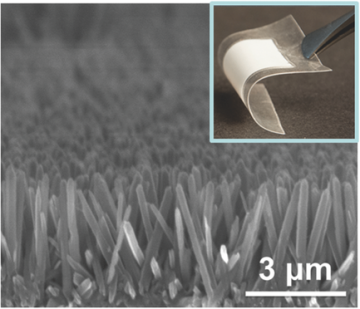A futuristic nanowire device may offer people the possibility of wearable, personal-cooling devices, according to a new study.
The devices could be a lifesaver for firefighters, astronauts, soldiers and anybody outside on the hottest summer days, the research team from Penn State write in the journal Advanced Materials.
“This low voltage is good enough for modest exercise and the material is flexible,” said Qing Wang, professor of materials science and engineering, and one of the authors.
The array can cool about 14 degrees Celsius (5.5 degrees Fahrenheit) using 36 volts – an electric level safe for humans to wear. The concept is powered by a battery pack about the size of an iPad, and weighing 500 grams.
The ferroelectric barium strontium titanate nanowire array is an electrocaloric material that shows reversible temperature changes under an electric field. Traditionally the materials used have been single crystals, ceramics in bulk or films – all of which are either heavy, bulky, or rigid. Ferroelectric polymers have flexibility, but require electric field power levels unsafe for close contact.
The conundrum was solved through a combination of the materials.
The titanium dioxide nanowires are grown on fluorinedoped tin oxide coated glass. A template ensured all the nanowires grow perpendicular to the glass surface, and to the same uniform height. Barium and strontium ions are infused into them during the process. A nanosheet of silver applied to the array serves as an electrode. The resulting material can be applied to a flexible surface, including clothing, using a sticky tape, they said.
“Most electrocaloric ceramic materials contain lead. We try not to use lead,” said Wang. “Conventional cooling systems use coolants that can be environmentally problematic as well. Our nanowire array can cool without these problems.” But the device is not yet ready to be made – since design challenges need to be tackled.
“Now we need to design a system that can cool a person and remove the heat generated in cooling from the immediate area,” Wang said. “Still, this work is anticipated to pave the way for the applicability of EC materials in personal cooling technologies where flexibility, efficiency, low field response, lightweight and scalability are of great importance.”
By Seth Augenstein, Laboratory Equipment 29/4/2016
http://www.laboratoryequipment.com/news/2016/04/personalcoolingunitsmadenanowires-couldbefuturebeatingheat
http://onlinelibrary.wiley.com/doi/10.1002/adma.201506118/full


